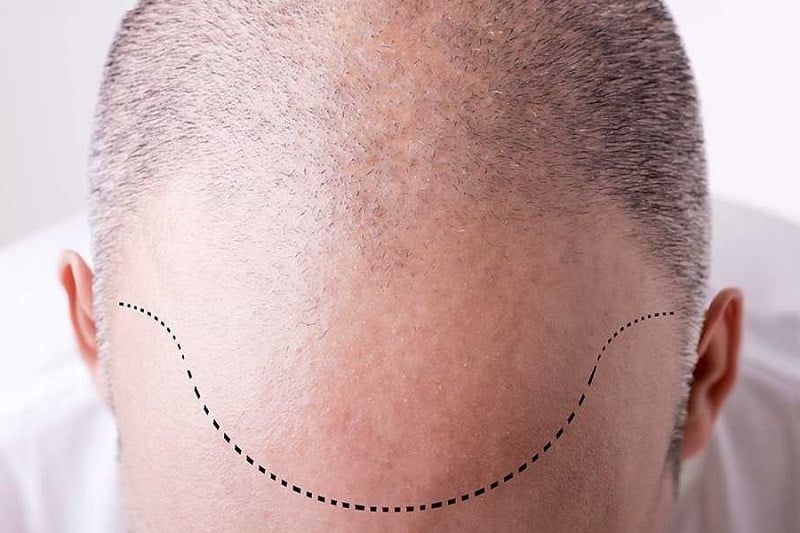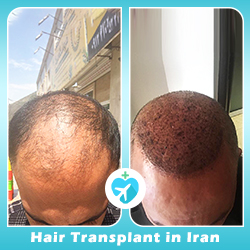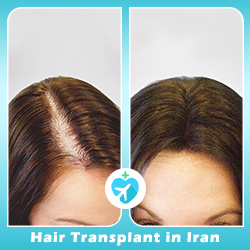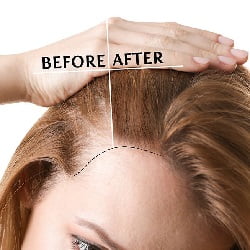Many people with a receding hairline are unhappy with their disproportionally large forehead. A receding hairline is caused by hair loss in the hairline area and is a common concern for both men and women. It is typically a hereditary condition and a part of the hair loss process caused by certain hormones that make hair follicles too sensitive, causing hair to fall out. When we lose a great number of hair strands at the front of our head, the hairline starts to move backward and the forehead appears larger. The normal space between the eyebrows and the hairline is 5 to 6.5 centimeters and a height greater than this is considered disproportionate.
That said, a high forehead that is disproportionate to other facial features is not always the result of a receding hairline. It may be a congenital physical trait, which means the person is born with a too big forehead.

The height of a forehead should not be more than 5-6.5 cm in order to be proportionate to other facial features.
A large forehead can be corrected with a cosmetic procedure. Depending on whether the problem is caused by male or female pattern hair loss or the high forehead is simply a congenital problem the person was born with, it can be corrected with a hair transplantation procedure or a surgical scalp advancement procedure, which is also referred to as hairline lowering, forehead reduction, and hairline advancement.
hairline lowering with hair transplant vs scalp advancement
If you have a large forehead you don’t like, chances are you are looking for options to reduce its size, but are not sure which one to choose. While there are advantages and disadvantages to different techniques for reducing the size of a forehead, the best option depends on the person’s circumstances and preferences.
There are two main approaches to lowering the hairline and reducing the size of the forehead: hair transplant and scalp advancement. The former is the same as a regular hair transplantation procedure, which involves harvesting hair follicles from other parts of the patient’s head and relocating them to the hairline area (frontal side of the head and the temples) and the latter is a surgical procedure involving a long incision along the hairline and removal of a portion of the forehead skin.
Hairline lowering with hair transplant
Hair transplantation, or hair grafting, is the most common way of hairline lowering. This approach is the preferred option for candidates who have thin hair at their hairline or who don’t like their uneven hairline. However, people should wait until their hair loss stops before going for a hair transplant for hairline correction because progressive hair loss will ruin the results of the procedure, creating a need for a second procedure in the future.
A hair transplant can also be an option for people with naturally large foreheads. Although these people often do not have a thin and uneven hairline, they can still consider a hair grafting procedure to add hairs to the front of their head to have a narrower forehead.

Hair transplantation is the most common method for hairline restoration.
One of the advantages of the hair grafting method is that it does not leave a scar on the treated area. However, if the FUT method is employed, a visible linear scar is left on the back of the head (donor area), where a strip of scalp is removed to harvest hair grafts from it for transplantation. This scar, however, will not be visible if you wear your hair long. An FUE hair transplant, on the other hand, leaves no visible scar on the donor area nor on the recipient area (hairline).
With a hair grafting, the hairline can be recreated in any shape the patient desires. For example, the surgeon can create an artificial widow’s peak (V-shaped growth of hair in the middle of the hairline) or remove a natural one to straighten or round the hairline. Therefore, this method is particularly appropriate for people who have special preferences with regard to the pattern and shape of their hairline, as well as those who desire a thick, sharply-defined hairline.
A drawback of a hairline restoration with hair grafting is that the results do not appear immediately. You have to wait at least 6 weeks to see the initial results of your procedure and up to 18 months to see the final results.
Forehead reduction with scalp advancement
A second option for hairline lowering is a surgical procedure called scalp advancement. In this technique, the surgeon makes an incision along the hairline from temple to temple. He/she then removes a portion of the skin (between 3-5 centimeters in width) and pulls the scalp down to reattach it to the remaining skin of the forehead using sutures.
The ideal candidates for surgical forehead reduction are women with high hairlines who do not have a family history of hair loss, but men too, are good candidates for this procedure. People with thick hairlines who are just unhappy with the size of their forehead and not with the shape of their hairline can consider a hairline lowering with scalp advancement.
Candidates for this forehead reduction technique should also have good skin elasticity. This is a very important factor because the scalp needs to be stretchable enough so that, after removing some of the skin, the edge of the scalp could be brought close to the edge of the forehead skin for stitching. The surgeon typically does a pinch test to determine if the scalp has enough flexibility for a scalp advancement surgery.
A big advantage to surgical hairline advancement is that you do not need to wait to see the result of the procedure and once the surgery is completed, the hairline gets lowered and the forehead gets reduced in size. Additionally, people with naturally high hairlines without a family history of hair loss do not need to wait until their hair loss stops.
The main disadvantage of the surgical hairline lowering is scarring. Since this method involves a long incision, a scar will normally be left in the hairline area. However, depending on the quality of healing, the surgeon’s skill, and the patient’s hairstyle, the scar is more or less concealed within the hairline and can be hardly visible.

Scarring is the main drawback of surgical forehead reduction surgery.
That said, a great idea to have the cake and eat it is to combine a scalp advancement surgery with a hair grafting procedure. This means that after lowering the hairline with the incisional method, the surgeon can transplant a number of hair grafts around the scar in order to make the hairline thicker and better conceal the future scar. The two procedures can be done at the same time or a few months apart.
Now that you have learned about all the aspects of the two approaches to forehead reduction, it is time to arrange an appointment with a specialist for a personal consultation. Our experts at AriaMedTour are also prepared to provide you with whatever questions you may have regarding these cosmetic surgeries. Feel free to send us a message and ask for a free consult and price quote.









